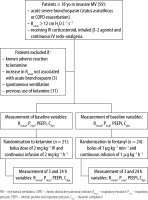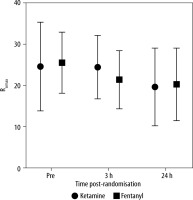Asthma and chronic obstructive pulmonary disease (COPD) are conditions characterised by airflow limitation. When not responding to standard treatments, both mandate critical care management and are potential life-threatening medical conditions [1, 2]. In acute exacerbations, an unwanted complication is severe bronchospasm, which may require the use of invasive mechanical ventilation (IMV) for its adequate management. Patients with these conditions usually present increased airway resistance, pulmonary hyperinsufflation and a large physiological dead space [3]. Usual pharmacological management of severe asthma and COPD exacerbation aims to resolve these alterations, and includes inhaled β-2 agonists, inhaled anticholinergics and glucocorticoids. Despite optimal pharmacological therapy, acute exacerbation of asthma that requires IMV is associated with a major economic and health burden, and COPD exacerbations in this scenario are associated with prolonged hospital stay and significant mortality [1, 2, 4]. Ketamine is a general anaesthetic molecule with sedative and analgesic properties [5]. Ketamine is supposed to produce airway relaxation and is commonly prescribed with this purpose, but the evidence supporting this effect is still scarce, especially in acute COPD exacerbations [6–8]. We aimed to evaluate whether continuous infusion of ketamine is associated with improvement in respiratory mechanics correlated with bronchospasm relief, as compared with continuous infusion of fentanyl – the most common IV continuous analgesia used, in critically ill, mechanically ventilated patients.
METHODS
This was a randomised, single-centre, evaluator-blinded, parallel-group trial, performed in a 59-bed tertiary intensive care unit (ICU) in Brazil, between January 2015 and December 2017. The protocol was approved by the local ethics committee (Plataforma Brasil 42324015.0.0000.5530) and was registered in ClinicalTrials.gov (NCT03000413).
Adult IMV ICU patients (age ≥ 18 years) were included if they had an acute severe bronchospasm, due to status asthmaticus or COPD exacerbation, with inspiratory resistance (Rsmax) ≥ 12 cm H2O L−1 s−1 and receiving at least intravenous corticosteroid, inhaled β-2 agonist and continuous intravenous analgosedation for optimisation of ventilator synchrony (Figures 1 and 2). All patients required neuromuscular blockade with continuous intravenous atracurium. Patients were excluded if they had a known adverse reaction to ketamine or an increase in Rsmax not associated with acute bronchospasm (bronchial obstruction, acute distress respiratory syndrome, pulmonary fibrosis) or if they had spontaneous ventilation. Patients were allocated using computer-generated block randomisation of size 8, and allocation concealment was provided by sequentially numbered, opaque, sealed envelopes. Patients received R-(−)ketamine (dextroketamine chloridrate, Laboratorio Cristália, Brazil) in a bolus dose of 2 mg kg−1 IV and a 24 hours (h) maintenance continuous infusion of 2 mg kg−1 h−1 or a standard IV continuous analgesia with fentanyl (bolus of 1 μg kg−1 min−1 and continuous infusion of 1 μg kg−1 min−1). Prolonged use of the study drugs (> 24 h) was at the discretion of the attending physician. All patients received IV continuous sedation (midazolam of propofol) according to the decision of the attending physician. Before the protocol was begun, baseline measurements were obtained for inspiratory pressure (Pinsp), Rsmax, intrinsic positive end-expiratory pressure (PEEPi) and dynamic compliance (Cdyn). The same variables were obtained at 3 and 24 h after randomisation. We performed the measurements of respiratory mechanics (Rsmax,, Cdyn, PEEPi) according to the literature on the topic [9]. All patients were ventilated in a Servo-i mechanical ventilator (Maquet, Getinge Group, Rastatt, Germany). The main outcome of this study was to evaluate the improvement of Rsmax in 3 h of continuous infusion of the study drugs. Secondary objectives were improvement in Rsmax in 24 h, improvement in Cdyn and PEEPi (3 and 24 h), duration of MV (in days) and ICU mortality.
Statistical analysis
Data are reported as the median (± IQR). Differences between groups were assessed by the Mann-Whitney test with a P significance limit < 0.05. The statistical analyses were all performed using SPSS software (version 17.0). The trial was stopped after enrolling 45 patients (21 in the ketamine group and 24 in the fentanyl group) due to time expiration, despite the initial plan of 90 patients to be included in the analysis. The lack of evidence quantitatively estimating a superior benefit of ketamine over fentanyl did not allow an accurate sample size calculation to be performed.
RESULTS
The main clinical charts are presented in Table 1. Overall ICU mortality of patients was high (65%) in a population with a high predicted mortality (mean SAPS 3 – Simplified Acute Physiology Score 3, score of 68 points). Ketamine was not associated with greater reduction in Rsmax compared to fentanyl, either after 3 h (0 ± 6 vs. −3 ± 7.7, respectively; P = 0.16) or after 24 h (−3 ± 17 vs. −3.5 ± 13.7, respectively; P = 0.73) (Figure 1). Delta Rsmax at 3 h was 0 cm H2O L−1 s−1 (CI 95%: −3.5 to 2.5) in the ketamine and −3 cm H2O L−1 s−1 (CI 95%: −12 to 1.7) in the fentanyl group (P = 0.16). At 24 h, delta Rsmax was −3 cm H2O L−1 s−1 (CI 95%: −15.5 to 1.5) in the ketamine and −3.5 cm H2O L−1 s−1 (CI 95%: −12 to 1.7) in the fentanyl group (P = 0.73). Patients randomised to the ketamine group did not have better improvements in delta PEEPi as compared with fentanyl at 3 h: 0 cm H2O (CI 95%: −1 to 1.5) vs. −0.5 cm H2O (CI 95%: −7.7 to 0), P = 0.77, respectively. Also, at 24 h there was no difference between treatments in delta PEEPi: −1 cm H2O (CI 95%: −3 to 1) in ketamine and −0.5 cm H2O (CI 95%: −4.7 to 1.7) in fentanyl group (P = 0.72). There was no difference between groups in delta Cdyn at 3 h: ketamine 0 mL cm H2O−1 (CI 95%: −2 to 2) and fentanyl 0 mL cm H2O−1 (CI 95%: −2 to 3), P = 0.85; as well as at 24 h: ketamine 1 mL cm H2O−1 (CI 95%: −6.5 to 3.5) and fentanyl 0.5 mL cm H2O−1 (CI 95%: −11.2 to 3.2), P = 0.35. In an exploratory subgroup analysis, asthma patients using ketamine had no difference in 3 h-delta Rsmax (P = 0.07). The subgroup of patients with COPD also showed no differences between groups in 3h-delta Rsmax (P = 0.19). Patients randomised to the ketamine group had a median of 7 (± 10) days, compared with 8.5 (± 9.7) days in the fentanyl group (P = 0.55). Patients in the ketamine group required a higher cumulative dose of fenoterol within 24 h of randomization compared to those receiving fentanyl (P = 0.04). Patients in the ketamine group did not receive a greater cumulative dose of midazolam in 24 h (P = 0.06) and 72 h (P = 0.57) compared to fentanyl but received a greater cumulative dose in 48 h (P = 0.01). Baseline, 3 h and 24 h heart rates were not different between groups; nor was median noradrenaline dose at the same time points.
TABLE 1
Baseline clinical variables
DISCUSSION
In this study, ketamine administration did not reduce inspiratory airway resistance or PEEPi, a surrogate of dynamic hyperinflation. Patients with COPD have an elevation in inspiratory Rsmax secondary to bronchospasm, airway inflammation and mucous production, whereas PEEPi signals obstruction to the expiratory flow present in patients with asthma or exacerbation of COPD. Ketamine was ineffective in improving respiratory mechanics in this scenario compared to fentanyl, and was not associated with a reduction in the number of days on mechanical ventilation, nor was it associated with lower mortality.
Few data support the use of ketamine in the management of acute bronchospasm, basically in the treatment of asthmatic conditions [5], in very heterogeneous populations and with the measurement of very different variables, mostly in retrospective studies [10]. In emergency department patients with acute asthma exacerbation, ketamine did not increase the bronchodilatory effect compared with standard therapy [7]. Our study included a more severe population, admitted to the ICU and submitted to IMV.
This study has the merit of prospectively evaluating a therapy sometimes used in the management of acute bronchospasm but with scarce evidence supporting its use. However, it has several limitations. First, it failed to reach the initially proposed number of randomised patients, because of a low inclusion rate. Second, adherence to the protocol was complete only for the first 24 h after inclusion, and it was at the discretion of the attending team whether to maintain therapy afterwards. Third, the high mortality rate of the patients studied may limit the extrapolation of these data to other clinical scenarios. Fourth, the joint analysis of patients with bronchospasm, with asthma or COPD does not allow a robust analysis of each subgroup of diseases, due to the low sample size. However, management of acute bronchospasm in patients submitted to IMV is broadly similar in both, despite different mechanisms of disease [11, 12]. The pharmacological treatment is quite similar, justifying the analysis of ketamine in this clinical setting. Fifth, we cannot estimate how many of the patients included had asthma–COPD overlap, a condition associated with defined characteristics of COPD as well as features of asthma, generally associated with a worse prognosis [12].
Until new evidence suggests otherwise, however, at least in this clinical setting, ketamine has not been shown to be more effective in the management of acute bronchospasm compared with standard fentanyl-based analgesia.




